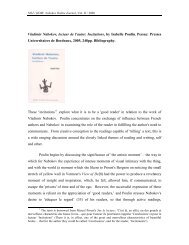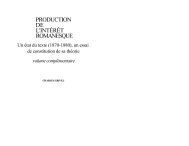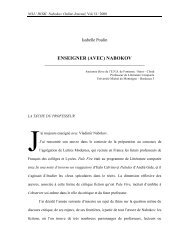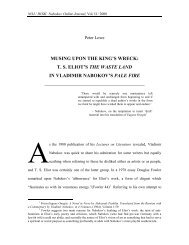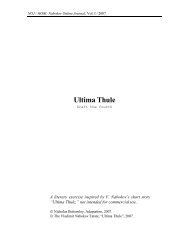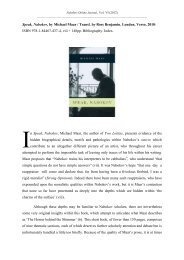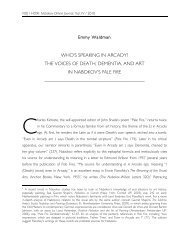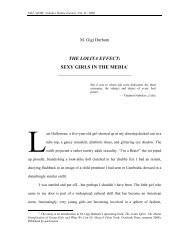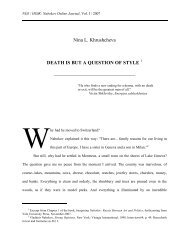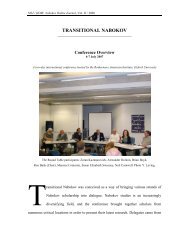domesticated translation: the case of nabokov's translation of alice's
domesticated translation: the case of nabokov's translation of alice's
domesticated translation: the case of nabokov's translation of alice's
You also want an ePaper? Increase the reach of your titles
YUMPU automatically turns print PDFs into web optimized ePapers that Google loves.
NOJ / НОЖ: Nabokov Online Journal, Vol. II / 2008<br />
Natalia Vid<br />
DOMESTICATED TRANSLATION:<br />
THE CASE OF NABOKOV’S TRANSLATION OF<br />
ALICE’S ADVENTURES IN WONDERLAND<br />
______________________________________________________<br />
DOMESTICATED VERSUS FOREIGNIZED<br />
What is <strong>translation</strong>? On a platter<br />
A poet's pale and glaring head,<br />
A parrot's screech, a monkey's chatter,<br />
And pr<strong>of</strong>anation <strong>of</strong> <strong>the</strong> dead.<br />
V. Nabokov, “On Translating<br />
Eugene Onegin” (1955)<br />
T<br />
he main question in <strong>the</strong> history <strong>of</strong> <strong>translation</strong> <strong>the</strong>ory has been <strong>the</strong> question <strong>of</strong><br />
<strong>the</strong> nature <strong>of</strong> <strong>translation</strong>. What is more important – to create a text which will<br />
be accepted in a target cultural environment or to preserve <strong>the</strong> formal and<br />
aes<strong>the</strong>tic original in order to evoke interest in a foreign culture? This dilemma <strong>of</strong>fers two<br />
primary methods <strong>of</strong> dealing with <strong>translation</strong>: <strong>domesticated</strong> 1 (emphasis on <strong>the</strong> language<br />
1 One <strong>of</strong> <strong>the</strong> most famous <strong>the</strong>orists <strong>of</strong> natural, <strong>domesticated</strong> <strong>translation</strong> is Nida Eugene, an<br />
American specialist <strong>of</strong> Bible <strong>translation</strong>s. She is considered to be a follower <strong>of</strong> Martin Lu<strong>the</strong>r, who<br />
translated <strong>the</strong> Bible into <strong>the</strong> common German language and declared <strong>the</strong> priority <strong>of</strong> content above form.
N. Vid. “Domesticated Translation”<br />
and culture <strong>of</strong> <strong>the</strong> target text) and foreignized 2 (emphasis on <strong>the</strong> language and culture <strong>of</strong><br />
<strong>the</strong> source text) <strong>translation</strong> strategies.<br />
Venuti defines <strong>domesticated</strong> <strong>translation</strong> as “an ethnocentric reduction <strong>of</strong> <strong>the</strong><br />
foreign text to target language cultural values, bringing <strong>the</strong> author back home.” In this<br />
<strong>case</strong> translator should erase every shred <strong>of</strong> foreignness and create a familiarized and<br />
immediately recognizable text, adjusted to <strong>the</strong> target text’s linguistic and cultural<br />
dimensions (1995: 20). On <strong>the</strong> contrary, followers <strong>of</strong> <strong>the</strong> foreignized method see <strong>the</strong><br />
source text as <strong>the</strong> only objective reality <strong>of</strong> a literary work. Their primary aim is to transfer<br />
<strong>the</strong> original idea <strong>of</strong> <strong>the</strong> text as exactly as possible – without any additional interpretations,<br />
explanations or adaptations. Using this method, <strong>the</strong> translator is expected to preserve <strong>the</strong><br />
foreign identity <strong>of</strong> <strong>the</strong> source text, i.e. to keep linguistic and cultural differences in <strong>the</strong><br />
<strong>translation</strong>. Foreignized <strong>translation</strong> gives readers more information about <strong>the</strong> foreign<br />
culture but tends to increase <strong>the</strong> difficulty <strong>of</strong> understanding <strong>the</strong> text.<br />
Translators who are disposed to <strong>the</strong> <strong>domesticated</strong> method proclaim that <strong>the</strong><br />
essential component <strong>of</strong> any literary work is not its “technical” side, but something<br />
invisible and <strong>of</strong>ten called <strong>the</strong> “spirit” <strong>of</strong> <strong>the</strong> original. This “spirit” has to be successfully<br />
transferred into <strong>the</strong> target culture. According to Nida Eugene, domestication also permits<br />
adjustments to “special literary forms,” “semantically exocentric expressions” or<br />
“intraorganismic meanings” (1964: 170). Naturalness, as a key requirement in this type <strong>of</strong><br />
<strong>translation</strong>, should be raised to such a degree that it “bear[s] no obvious trace <strong>of</strong> foreign<br />
origin” (1964: 167).<br />
2 Domesticated <strong>translation</strong> is also described as target language (TL) or “reader-to-author”<br />
approach and foreignized, as source language (SL) or “author-to-reader.”
NOJ / НОЖ: Nabokov Online Journal, Vol. II / 2008<br />
Scholars in modern <strong>translation</strong> <strong>the</strong>ory such as Tymoczko (1999: 55-56), deny <strong>the</strong><br />
existence <strong>of</strong> a single polarity that describes <strong>the</strong> orientation <strong>of</strong> a <strong>translation</strong> and criticize<br />
this dichotomy. Tymoczko points out that a <strong>translation</strong> “may be radically oriented to <strong>the</strong><br />
source text in some respects, but [could] depart radically from <strong>the</strong> source text in o<strong>the</strong>r<br />
respects so as to assimilate it to a norm <strong>of</strong> a receiving culture” (Tymoczko 1995: 21).<br />
The truth has not been established yet. Domesticated <strong>translation</strong> is more natural<br />
and easy to understand because it is read as an original text. Foreignized <strong>translation</strong><br />
presents a foreign language and culture and for that reason requires a certain level <strong>of</strong><br />
knowledge about <strong>the</strong> source cultural environment. Both methods are mutually hostile,<br />
and <strong>the</strong> dualism still exists in <strong>the</strong> <strong>the</strong>ory and practice <strong>of</strong> <strong>translation</strong> while different reasons<br />
and evidence are provided to prove <strong>the</strong> primacy <strong>of</strong> each method.<br />
In <strong>the</strong> history <strong>of</strong> modern <strong>translation</strong> <strong>the</strong>re are scarcely any examples <strong>of</strong><br />
“betraying” one method and moving to <strong>the</strong> opposite approach. One <strong>of</strong> <strong>the</strong> rarest<br />
exceptions is Vladimir Nabokov, who used both methods in establishing his <strong>translation</strong><br />
doctrine. Only a few translators in <strong>the</strong> twentieth century possessed Nabokov's linguistic<br />
sensibility, and his contribution to <strong>the</strong> <strong>the</strong>ory <strong>of</strong> <strong>translation</strong> and practice is invaluable. In<br />
his <strong>translation</strong> <strong>of</strong> Lewis Carroll’s novel Alice’s Adventures in Wonderland, young<br />
Nabokov-Sirin used a <strong>domesticated</strong> method <strong>of</strong> radically familiarizing <strong>of</strong> <strong>the</strong> original. In<br />
contrast, his later <strong>translation</strong> <strong>of</strong> Pushkin’s novel in verse, Eugene Onegin, signified a<br />
complete transition to an extreme foreignized <strong>translation</strong>, aimed at keeping <strong>the</strong> original<br />
text as au<strong>the</strong>ntic as possible.<br />
This article focuses on <strong>the</strong> <strong>translation</strong> <strong>of</strong> Alice’s Adventures in Wonderland,<br />
exploring problems in <strong>translation</strong> arising from <strong>the</strong> differences between two languages and
N. Vid. “Domesticated Translation”<br />
cultural milieus. I will analyze Nabokov’s <strong>domesticated</strong> strategies <strong>of</strong> familiarization <strong>of</strong><br />
<strong>the</strong> linguistic and literary properties in <strong>the</strong> process <strong>of</strong> adjustment <strong>of</strong> Carroll’s text to its<br />
target audience.<br />
THE TRANSLATION OF ALICE’S ADVENTURES IN WONDERLAND:<br />
A CHALLENGE IN TRANSLATING CHILDREN’S LITERATURE<br />
Translating Alice’s Adventures in Wonderland to any language is definitely not<br />
among <strong>the</strong> easiest tasks. The novel contains parodies, puns (especially <strong>the</strong> frequent use <strong>of</strong><br />
homophones), wordplay, verbal humor, “speaking” names, personifications, enciphered<br />
allusions, literal interpretations <strong>of</strong> phraseological components, and unusual metaphors, as<br />
well as o<strong>the</strong>r elements <strong>of</strong> Carroll’s creative style which appear on every single page and<br />
result in paradoxically humorous effects, making this book a real challenge for<br />
translators. Lewis Carroll’s tale is notable for its varied and distinctive use <strong>of</strong> style, clear<br />
intertextuality and <strong>the</strong> interplay between fiction and reality.<br />
Moreover, Alice includes numerous details characteristic <strong>of</strong> an epoch and society<br />
– Victorian England. Modern English readers are probably still able to identify those<br />
features in <strong>the</strong> text oriented to a particular culture and period, but Russian readers would<br />
fail comprehending <strong>the</strong>m without additional explanations. The Russian translator Boris<br />
Zakhoder, who successfully translated Winnie-<strong>the</strong>-Pooh, was frequently asked: “Why<br />
don’t you translate Alice?” whereupon he answered: “It would be easier to transpose<br />
England” (quoted in Nikolaeva 1996: 89). Ever since it was first brought into Russian in<br />
1879, Alice’s Adventures in Wonderland intrigued and sorely tested Russian translators.
NOJ / НОЖ: Nabokov Online Journal, Vol. II / 2008<br />
Despite <strong>the</strong> fact that Carroll himself believed that <strong>the</strong> book is virtually untranslatable (as<br />
he reportedly said in connection with <strong>the</strong> first French <strong>translation</strong>; see, Kibbee 2003: 308),<br />
Alice was translated more <strong>of</strong>ten than almost any o<strong>the</strong>r work, except for <strong>the</strong> Bible<br />
(Carpenter/Prichard, 1984: 17).<br />
Prior to turning to Nabokov’s <strong>translation</strong> <strong>of</strong> Alice, I will summarize <strong>the</strong><br />
characteristics typical to translating children’s literature in general. Contrary to common<br />
belief, translating for children might not be easier than translating for adults. Since<br />
“children’s semiotic experience does not allow <strong>the</strong>m to interpret <strong>the</strong> signs <strong>of</strong> an alien<br />
semiosphere” (Nikolaeva 1996: 27), a variety <strong>of</strong> explanations, adaptations or direct<br />
changes may be necessary. In his research <strong>of</strong> translating children’s literature, Zohar<br />
Shavit suggests that <strong>the</strong> translator <strong>of</strong> children’s literature may manipulate <strong>the</strong> text in<br />
various ways. Such freedom is allowed as long as <strong>the</strong> translator is adjusting <strong>the</strong> text to<br />
make it appropriate and comprehensible for children. Considering children’s ability to<br />
read and comprehend, some translators may even choose to modify <strong>the</strong> plot, characters<br />
and language (1986: 112-113); o<strong>the</strong>rs can delete or change inappropriate scenes to make<br />
<strong>the</strong> text more accessible for young readers (1981: 174).<br />
Thus, <strong>the</strong> main task <strong>of</strong> a translator <strong>of</strong> children’s literature is to make it relevant for<br />
<strong>the</strong> target audience. Riitta Oittinen states that “[in] translating as rewriting for target-<br />
language audiences – we always need to ask <strong>the</strong> crucial question: ‘For whom?’ Hence,<br />
while writing children’s books is writing for children, translating children’s literature is<br />
translating for children” (2003: 128). The interests <strong>of</strong> <strong>the</strong> readers, in this <strong>case</strong> children,<br />
should be taken even more seriously than <strong>the</strong> interests <strong>of</strong> <strong>the</strong> adults.
N. Vid. “Domesticated Translation”<br />
Children’s literaure scholar Zena Su<strong>the</strong>rland maintains that what may be a mild<br />
hazard for an adult can pose a serious barrier for a child. For instance, names, titles,<br />
complex syntax, or allusions to cultural heritage or common knowledge in foreign<br />
literature may be unfamiliar to members <strong>of</strong> recipient cultures. The translator <strong>of</strong> children’s<br />
literature must keep this fact in mind in order to avoid creating an overly difficult<br />
uninteresting <strong>translation</strong> which may alienate children from reading (1981: 67). Su<strong>the</strong>rland<br />
agrees that in <strong>the</strong> realm <strong>of</strong> children’s literature a “new,” <strong>domesticated</strong> and familiar text<br />
can be created instead <strong>of</strong> a literary “<strong>translation</strong>” <strong>of</strong> <strong>the</strong> original text (1981: 69).<br />
It is difficult to decide which elements in <strong>the</strong> source text can be preserved and<br />
which should perhaps be omitted. According to Nikolaeva, <strong>the</strong> best <strong>translation</strong> <strong>of</strong> a<br />
children’s book does not necessarily entail precise accuracy and closeness to <strong>the</strong> original.<br />
It is much more important to consider <strong>the</strong> issues <strong>of</strong> reception and <strong>the</strong> readers’ response.<br />
The children have to be able “to accept and utilize <strong>the</strong> book.” An effective <strong>translation</strong><br />
should arouse in <strong>the</strong>m <strong>the</strong> same feelings and associations experienced by <strong>the</strong> young<br />
readers <strong>of</strong> <strong>the</strong> source text (1996: 28).<br />
This vision <strong>of</strong> translating children’s literature seems logical. Children, with <strong>the</strong>ir<br />
imperfect reading abilities and limited world knowledge cannot, and are not expected to<br />
tolerate as much strangeness and foreignness as adult readers. On <strong>the</strong> o<strong>the</strong>r hand, keeping<br />
in mind <strong>the</strong> target audience does not mean that <strong>the</strong> original should be oversimplified and<br />
that children should not be challenged. It is <strong>the</strong> task <strong>of</strong> <strong>the</strong> translator to make appropriate<br />
decisions on how she/he will compensate for <strong>the</strong> children’s lack <strong>of</strong> background<br />
knowledge without oversimplifying <strong>the</strong> original and “forcing children into simple texts<br />
that have lost any feature <strong>of</strong> difficulty, foreignness, challenge and mystery” (Stolze 2003:
NOJ / НОЖ: Nabokov Online Journal, Vol. II / 2008<br />
209). However, as Umberto Eco writes in <strong>the</strong> Introduction to Experiences in Translation:<br />
“Every sensible and rigorous <strong>the</strong>ory <strong>of</strong> language shows that a perfect <strong>translation</strong> is an<br />
impossible dream” (Eco 2001: ix).<br />
Nabokov’s <strong>translation</strong> <strong>of</strong> Alice into Russian is admittedly successful. Obviously,<br />
in translating Carroll’s novel (1923), Nabokov considered primarily his future readers’<br />
abilities and interests, tending to create a <strong>translation</strong> that would be as accessible as<br />
possible to <strong>the</strong> mind <strong>of</strong> a child. He tried to convey to <strong>the</strong> Russian children <strong>the</strong> humor, <strong>the</strong><br />
originality and <strong>the</strong> brightness <strong>of</strong> <strong>the</strong> paradoxical and attractive Carroll's world, his sense<br />
<strong>of</strong> <strong>the</strong> absurd, and his amazing gift for games <strong>of</strong> logic and language. Just as a foreignized<br />
<strong>translation</strong> is intended to create a feeling <strong>of</strong> entering an unknown world, a <strong>domesticated</strong><br />
<strong>translation</strong> must provide a recognizable and familiar atmosphere for <strong>the</strong> reader. At <strong>the</strong><br />
same time, Nabokov refused to oversimplify his <strong>translation</strong> or to patronize its young<br />
audience with simplistic <strong>translation</strong> solutions.<br />
TRANSLATING PARODIES<br />
The novel Alice’s Adventures in Wonderland presents dilemmas to all translators.<br />
Julian W. Connolly calls Nabokov’s version “one <strong>of</strong> <strong>the</strong> most ingenious and delightful”<br />
(1995: 19). Exploring Nabokov’s <strong>translation</strong> methods <strong>of</strong> adaptation <strong>of</strong> <strong>the</strong> original to <strong>the</strong><br />
Russian milieu, Connolly particularly stresses his “free spirited approach” in transferring<br />
Carroll’s parodies <strong>of</strong> didactic verses (1995: 20-21) with admirable ingenuity and<br />
creativity. The poems in Alice are parodies upon familiar rhymes which are related and<br />
intertextually connected to <strong>the</strong> Victorian English culture. It is clear that <strong>the</strong> target readers
N. Vid. “Domesticated Translation”<br />
<strong>of</strong> translated text would not easily embrace <strong>the</strong> subtle Victorian parodies. Thus, <strong>the</strong><br />
adaptation required replacing <strong>the</strong> parody <strong>of</strong> <strong>the</strong> didactic verses common in Victorian<br />
pedagogy with Nabokov’s own parody <strong>of</strong> Russian poems, especially those which his<br />
young readers were expected to recognize. In fact, successful <strong>translation</strong> <strong>of</strong> <strong>the</strong> verse<br />
parodies constitutes one <strong>of</strong> <strong>the</strong> most important adaptations to <strong>the</strong> target audience <strong>of</strong><br />
Russian children. Nabokov was strongly criticized for providing examples from Russian<br />
poetry and even accused <strong>of</strong> unnecessary Russification <strong>of</strong> <strong>the</strong> story and erasing any shade<br />
<strong>of</strong> <strong>the</strong> “English” spirit (Demurova 2003: 184). However, it is unreasonable to expect any<br />
Russian child to understand <strong>the</strong> parody <strong>of</strong> Isaak Watts or Robert Sou<strong>the</strong>y. By choosing<br />
popular Russian verses, Nabokov preserved Carroll’s intention <strong>of</strong> having his readers<br />
guess <strong>the</strong>m. 3 This ability to capture <strong>the</strong> challenging element <strong>of</strong> playing with <strong>the</strong> text<br />
proved to be Nabokov’s significant achievement in translating Alice.<br />
Connolly points out that Nabokov chose Mikhail Lermontov's long poem,<br />
“Borodino,” devoted to <strong>the</strong> glorious victory <strong>of</strong> <strong>the</strong> Russian army over <strong>the</strong> French invasion<br />
forces (1812) on <strong>the</strong> Borodino field (1995: 19), to adapt Carroll’s parody <strong>of</strong> Robert<br />
Sou<strong>the</strong>y’s “The Old Man’s Comforts and How He Gained Them” (“You are Old, Fa<strong>the</strong>r<br />
William”). As a result, Nabokov achieved a comical effect by evoking a calssical poem;<br />
he even managed to preserve Carroll’s original meter, rhyme, and <strong>the</strong> meaning <strong>of</strong> <strong>the</strong> first<br />
line <strong>of</strong> each couplet, which reads like in Lermontov: “Skazhi-ka diadia” (“Tell me,<br />
uncle”). Moreover, Lermontov’s poem was composed in a form <strong>of</strong> a dialogue between a<br />
recruit and an old soldier. Thus, Nabokov even preserved <strong>the</strong> aspect <strong>of</strong> <strong>the</strong>me-parody as<br />
in <strong>the</strong> original young Alice talks to <strong>the</strong> elder and wiser Caterpillar.<br />
3 Time proved that Nabokov invented <strong>the</strong> most appropriate method <strong>of</strong> rendering Carroll’s parody<br />
which was also used by one <strong>of</strong> <strong>the</strong> modern translators <strong>of</strong> Alice, A. Kononenko (1998-2000), who<br />
substituted <strong>the</strong> original verses with Pushkin’s and Lermontov’s poems as well as with Krylov’s fable.
NOJ / НОЖ: Nabokov Online Journal, Vol. II / 2008<br />
As Connolly notes, Nabokov also used Pushkin’s poem “Gypsies” – <strong>the</strong> line from<br />
“Ptichka Bozhiia ne Znaet” (“God’s Bird Doesn’t Know”) instead <strong>of</strong> <strong>the</strong> parody <strong>of</strong> Isaak<br />
Watt’s “Against Idleness and Mischief” (in Carroll’s “How Doth <strong>the</strong> Little Crocodile”) 4<br />
(1995: 20). In <strong>the</strong> original poem, Watts uses an image <strong>of</strong> a bee as a model <strong>of</strong> hard work.<br />
In Carroll's parody, <strong>the</strong> crocodile is pictured as a deceptive and predatory creature. In<br />
Pushkin’s original poem, <strong>the</strong> image <strong>of</strong> <strong>the</strong> bird is used as a symbol <strong>of</strong> <strong>the</strong> independent and<br />
freedom-loving Gypsies. Translated parody sounds recognizable and funny because<br />
Nabokov, like Carroll, uses <strong>the</strong> image <strong>of</strong> a “cheating,” deceptive crocodile.<br />
Connolly also notes that in order to translate Carrol's “The Lobster Quadrille,” an<br />
original parody <strong>of</strong> Mary Botham Howitt’s “The Spider and <strong>the</strong> Fly,” Nabokov chose<br />
Pushkin’s poem “Pesn’ o veschchem Olege” (“The Song <strong>of</strong> Prophetic Oleg”) (1995:21), a<br />
ballad about a Russian warrior who was foretold that his favorite horse would become a<br />
cause <strong>of</strong> his death. At <strong>the</strong> end <strong>of</strong> <strong>the</strong> poem, Oleg is bitten by a snake that hides in <strong>the</strong> head<br />
<strong>of</strong> his dead horse. Nabokov preserved <strong>the</strong> original rhyme <strong>of</strong> <strong>the</strong> ballad and used <strong>the</strong> key-<br />
word “veshchii” (“prophet”) in <strong>the</strong> first line to make <strong>the</strong> poem more recognizable.<br />
There are two more parodies successfully conveyed by Nabokov which were<br />
described by Demurova (2003: 188-189): Lermontov's poem, “Kazach’ia kolybel’naia”<br />
(“Cossack’s Lullaby”), and a famous folk verse “Chizhyk-Pyzhik, gde ty byl” (“Chizhyk-<br />
Pyzhik, where have you been”). “Cossack’s Lullaby” is used in <strong>the</strong> <strong>translation</strong> <strong>of</strong> lullaby<br />
sung by <strong>the</strong> Queen <strong>of</strong> Hearts (“Speak roughly to your little boy..."), although <strong>the</strong> chosen<br />
poem is not as efficient as “The Lobster Quadrille” because <strong>the</strong> parody remains lyrical<br />
and pompous. Supposedly, Lermontov's poem was not very well-known by children, at<br />
bee.”<br />
4 According to ano<strong>the</strong>r version, this is a parody on <strong>the</strong> child's rhyme “How doth <strong>the</strong> little busy
N. Vid. “Domesticated Translation”<br />
least not as <strong>the</strong> children’s folk verse “Chizhyk-Pyzhik, gde ty byl,” used to translate a<br />
parody <strong>of</strong> <strong>the</strong> famous nursery rhyme “Twinkle Twinkle, Little Star.”<br />
By choosing <strong>the</strong> strategy <strong>of</strong> substitution, Nabokov manipulated famous verses <strong>of</strong><br />
<strong>the</strong> target culture in order to ensure that <strong>the</strong> text is as meaningful and as accessible to <strong>the</strong><br />
target text reader as it was to <strong>the</strong> source text reader.<br />
CULTURAL ADAPTATIONS<br />
“Since successful <strong>translation</strong> depends on a double awareness <strong>of</strong> <strong>the</strong> cultural<br />
context in which <strong>the</strong> original was produced and <strong>of</strong> <strong>the</strong> context into which it is to be<br />
projected,” says Brower in his Introduction to <strong>the</strong> collection <strong>of</strong> essays on <strong>translation</strong>, “it<br />
will <strong>of</strong>ten reveal strikingly <strong>the</strong> likeness and differences between two civilizations”<br />
(Brower 1966: 5). Carroll’s novel reflects <strong>the</strong> time in which it was written. According to<br />
Hagfors, <strong>the</strong> use <strong>of</strong> culture-bound elements, such as proper names, food items, measures<br />
<strong>of</strong> length and currency, histocial figures, etc., is “one way <strong>of</strong> demonstrating not only into<br />
which culture <strong>the</strong> story is set but also <strong>of</strong> creating an atmosphere that reflects <strong>the</strong> values<br />
prevalent in that culture and period <strong>of</strong> time” (2003: 188). She stresses that to translate a<br />
book is a special challenge because <strong>the</strong> translator and <strong>the</strong> publisher have to decide<br />
whe<strong>the</strong>r “<strong>the</strong>y want to imply <strong>the</strong>se same values for <strong>the</strong> target text readers, or whe<strong>the</strong>r <strong>the</strong>y<br />
want to make adaptations to <strong>the</strong> text in order to fit it better into <strong>the</strong> target culture”<br />
because <strong>the</strong>ir decision will define <strong>the</strong> text’s “destiny” in <strong>the</strong> target culture (2003: 118).<br />
There are many British cultural references in Alice that can become problematic<br />
in <strong>translation</strong>. When dealing with cultural elements, Nabokov’s <strong>translation</strong> adopts <strong>the</strong>
NOJ / НОЖ: Nabokov Online Journal, Vol. II / 2008<br />
strategy <strong>of</strong> localization which means that <strong>the</strong> translator attempts “to anchor a reference<br />
firmly in <strong>the</strong> culture <strong>of</strong> <strong>the</strong> target audience” (Davies 2003: 72). Obviously, he considered<br />
expressions typical <strong>of</strong> <strong>the</strong> English cultural background to be incomprehensible to <strong>the</strong><br />
Russian readers and decided to erase all possible awareness <strong>of</strong> a different cultural<br />
content. Undoubtedly, this decision created a sense <strong>of</strong> familiarity and helped Russian<br />
readers to enter <strong>the</strong> magnificent world <strong>of</strong> Carroll’s book and to identify <strong>the</strong>mselves with<br />
<strong>the</strong> characters <strong>of</strong> <strong>the</strong> story. On <strong>the</strong> o<strong>the</strong>r hand, an almost complete familiarization <strong>of</strong><br />
cultural items can hardly serve as a tool for learning about foreign cultures, times and<br />
customs.<br />
Nabokov’s substitutions extend to <strong>the</strong> smallest details <strong>of</strong> Russian cultural milieu.<br />
For instance, he used both Russian measures <strong>of</strong> length and monetary units. When Alice<br />
falls into <strong>the</strong> rabbit hole, she talks about distance in terms <strong>of</strong> miles. Russian children<br />
might not be familiar with “miles,” but <strong>the</strong>y had to realize that <strong>the</strong> word referred to a very<br />
long distance. Nabokov used <strong>the</strong> word “versta,” choosing a more easily understandable<br />
concept <strong>of</strong> distance for Russian children. Connolly notes that <strong>the</strong> sum <strong>of</strong> one hundred<br />
pounds becomes one thousand rubles and shillings and pence are converted to kopecks<br />
(Connolly 1995: 19).<br />
Food items, 5 which <strong>of</strong>ten play an important role in children’s books, are also<br />
replaced with Russian analogs. In Alice, food is <strong>of</strong>ten used as a way <strong>of</strong> gaining entry into<br />
<strong>the</strong> o<strong>the</strong>r world. Some items, well-known in Russia at that time, such as “roast turkey,”<br />
“pine-apple,” or “currants” are translated directly. The supposedly unknown sweets were<br />
substituted with titles <strong>of</strong> typical Russian food items. Thus, “comfits” are replaced simply<br />
5 The significant role <strong>of</strong> food in children’s literature in general has been discussed in detail by<br />
Nikolaeva (2000: 128-130).
N. Vid. “Domesticated Translation”<br />
with “candies” (конфеты); <strong>the</strong> word “pirozhki” (пирожки), a typical Russian word for<br />
“pies”, is used instead <strong>of</strong> “tarts”; “hot buttered toast” becomes “grenki” (гренки), and<br />
“barley sugar” is translated as “sweets” (сладости). Nabokov also changed “orange”<br />
marmalade into “strawberry” marmalade, supposedly, because oranges were an exotic<br />
fruit in Russia and children would not have imagined such a “rarity” to be used for<br />
marmalade.<br />
Carroll’s story is also full <strong>of</strong> cultural references, most <strong>of</strong> which only make sense<br />
in <strong>the</strong>ir British/Victorian context. For instance, historical figures, such as William <strong>the</strong><br />
Conqueror, Edwin, <strong>the</strong> Earl <strong>of</strong> Mercia, Morcar, <strong>the</strong> Earl <strong>of</strong> Northumbria, Stigand, <strong>the</strong><br />
Archbishop <strong>of</strong> Canterbury, and Edgar A<strong>the</strong>lin, are mentioned in <strong>the</strong> Mouse’s story.<br />
Following his strategy <strong>of</strong> familiarization and localization, Nabokov transformed fictional<br />
characters and historical persons so that <strong>the</strong>y would fit better into a Russian milieu. The<br />
most famous adaptation, which is also mentioned by Connolly (1995: 19), is <strong>the</strong><br />
modification <strong>of</strong> <strong>the</strong> story told by <strong>the</strong> French Mouse who comes to England with William<br />
<strong>the</strong> Conqueror. In Nabokov’s <strong>translation</strong>, England is replaced with Russia and William<br />
<strong>the</strong> Conqueror is replaced with Vladimir Monomakh (a Russian Grand Prince). It is<br />
questionable whe<strong>the</strong>r all Russian children know who Vladimir Monomakh was and so it<br />
is unclear whe<strong>the</strong>r Nabokov achieved his goal <strong>of</strong> making this character more accessible<br />
to his readers. In fact, William <strong>the</strong> Conqueror is first mentioned when Alice encounters<br />
<strong>the</strong> Mouse in <strong>the</strong> second chapter, but in that <strong>case</strong> Nabokov replaces William <strong>the</strong><br />
Conqueror with Napoleon, probably considering <strong>the</strong> French emperor to be a more<br />
recognizable historical figure to a Russian audience. By introducing two completely<br />
different cultural milieus, Nabokov does not avoid a significant misunderstanding. The
NOJ / НОЖ: Nabokov Online Journal, Vol. II / 2008<br />
nationality <strong>of</strong> <strong>the</strong> Mouse is supposed to be French but <strong>the</strong> identity <strong>of</strong> <strong>the</strong> character whom<br />
<strong>the</strong> Mouse followed to <strong>the</strong> shore appears to be Russian.<br />
Edwin and Morcar, <strong>the</strong> Earls <strong>of</strong> Mercia and Northumbria, Stigand, and <strong>the</strong><br />
Archbishop <strong>of</strong> Canterbury disappear in Nabokov’s <strong>translation</strong> and are replaced with<br />
Monomakh’s son, Mstislav, and <strong>the</strong> grand prince Olegovich.<br />
All cultural references indicating that <strong>the</strong> story is set in Britain are deliberately<br />
omitted in Nabokov’s <strong>translation</strong> and this practice includes, quite consistently, <strong>the</strong> names<br />
<strong>of</strong> all characters. In order to make it easier for <strong>the</strong> reader to identify with <strong>the</strong> main<br />
characters and to avoid alienation throughout <strong>the</strong> reading process, Nabokov decided to<br />
Russify English personal names. As Christiana Nord points out, just a quick glance at <strong>the</strong><br />
translated text reveals that translators <strong>of</strong>ten substitute, transcribe and omit names (2003:<br />
182). Obviously, <strong>the</strong> presence <strong>of</strong> foreign names in a <strong>translation</strong> brings with it <strong>the</strong> risk <strong>of</strong><br />
creating a linguistic barrier for young readers. According to Tymoczko, <strong>the</strong> referential<br />
function <strong>of</strong> <strong>the</strong> names presupposes <strong>the</strong>ir “recognizability” and “memorability” because<br />
<strong>the</strong>y must “in some way be memorable so as to serve <strong>the</strong>ir function as indicators <strong>of</strong><br />
unique objects” (1999: 225).<br />
It is clear that unfamiliar foreign names may be difficult for children to recognize<br />
and memorize. On <strong>the</strong> o<strong>the</strong>r hand, names are an important part <strong>of</strong> <strong>the</strong> original text as <strong>the</strong>y<br />
<strong>of</strong>ten carry out <strong>the</strong> function <strong>of</strong> characterizing a person or a place. A translator, <strong>the</strong>refore,<br />
has to make a decision to ei<strong>the</strong>r find a completely new name or keep it <strong>the</strong> same as in <strong>the</strong><br />
original.<br />
It would be an impossible task to preserve all personal allusions in <strong>the</strong> Russian<br />
language, <strong>the</strong>refore Nabokov used <strong>the</strong> substitution strategy and tried preserving <strong>the</strong>
N. Vid. “Domesticated Translation”<br />
original name-play. 6 This served as a pattern for creating a humorous effect and evoking<br />
certain associations.<br />
Almost all <strong>of</strong> <strong>the</strong> culture-bound elements related to proper names are<br />
<strong>domesticated</strong> to make <strong>the</strong>m fit into <strong>the</strong> Russian target culture. To achieve this aim,<br />
Nabokov drew on <strong>the</strong> whole repertoire <strong>of</strong> names existing in <strong>the</strong> Russian language. Thus,<br />
Alice was transformed into Ania, 7 a diminutive <strong>of</strong> a common Russian name, Anna. This<br />
decision is one <strong>of</strong> <strong>the</strong> most contentious, because <strong>the</strong> change <strong>of</strong> <strong>the</strong> girl’s name entails <strong>the</strong><br />
change <strong>of</strong> <strong>the</strong> title as well: Ania v Strane Chudes. Nabokov remains <strong>the</strong> only Russian<br />
translator in <strong>the</strong> twentieth century who changed <strong>the</strong> name <strong>of</strong> Carroll’s protagonist. All<br />
o<strong>the</strong>r translators have retained <strong>the</strong> name used in <strong>the</strong> original.<br />
In <strong>the</strong> second chapter, Alice loses her self-assurance and fears that she may have<br />
become “Ada” or “Mabel.” Nabokov retains <strong>the</strong> name “Ada” but replaces “Mabel” with<br />
“Assia,” emphasizing Alice’s doubts about her identity by establishing sound similarity<br />
between <strong>the</strong> names: Ania-Ada-Assia. “Mary-Ann,” <strong>the</strong> name <strong>the</strong> White Rabbit uses to call<br />
Alice, is replaced with “Masha,” ano<strong>the</strong>r popular Russian female name.<br />
Two o<strong>the</strong>r common names appear in <strong>the</strong> fourth chapter. Servants who work for<br />
<strong>the</strong> White Rabbit are named “Pat” and “Bill.” In <strong>the</strong> <strong>translation</strong>, Bill is replaced with<br />
Iashka (a colloquial diminutive <strong>of</strong> <strong>the</strong> Russian name, Iakov) and Pat with Pet’ka (a<br />
colloquial diminutive <strong>of</strong> <strong>the</strong> Russian name, Peter). Both <strong>of</strong> <strong>the</strong> colloquial diminutives<br />
signify <strong>the</strong> social position <strong>of</strong> <strong>the</strong> servants because in <strong>the</strong> Russian language diminutives <strong>of</strong><br />
personal names are usually used to express familiarity or, sometimes, even disrespect.<br />
Similarly, as Kibbee states, <strong>the</strong> name “Pat” has clear cultural connotation, being <strong>the</strong><br />
6 For instance, “Mock Turtle” was translated as “chepupakha” (Connloy 1995: 22).<br />
7 The first <strong>translation</strong> <strong>of</strong> Alice into Russian was entitled Sonia v strane Diva (1879).
NOJ / НОЖ: Nabokov Online Journal, Vol. II / 2008<br />
stereotypical Irish name. “Pat” also encompasses many stereotypical features <strong>of</strong> <strong>the</strong> Irish<br />
dialect (“sure” at <strong>the</strong> beginning <strong>of</strong> a statement, “yer” for “your,” <strong>the</strong> pronunciation<br />
“arrum” for “arm,” etc.) (2003: 311). This ethnic and class identification is lost in<br />
Nabokov’s <strong>translation</strong>.<br />
Elsie, Lacie, and Tillie in <strong>the</strong> Dormouse’s story were renamed Masia, Pasia and<br />
Dasia (derivatives <strong>of</strong> <strong>the</strong> Russian names Masha, Pasha and Dasha) which, according to<br />
Connolly, allowed Nabokov to transfer <strong>the</strong> effect <strong>of</strong> sound repetition (1995: 19). The<br />
word “dormouse” was not a <strong>translation</strong> challenge because it has an equivalent in Russian<br />
which Nabokov used. The Russian word “sonia” has two uses: it can mean a dormouse<br />
and a person who likes to sleep, but it can also be a woman’s name. Considering both<br />
uses <strong>of</strong> this word, Nabokov was able to transfer <strong>the</strong> important characteristic <strong>of</strong> <strong>the</strong><br />
mouse’s sleepiness as well as add female connotations to her image. 8<br />
The absence <strong>of</strong> associative fields created a difficulty for Nabokov as well as for<br />
o<strong>the</strong>r translators <strong>of</strong> Alice into <strong>the</strong> Russian language. Carroll’s original is sated with<br />
allusions, hints, “speaking” names which, once translated into a different language, lose<br />
<strong>the</strong>ir hidden meaning. In <strong>the</strong> original, <strong>the</strong>re appears a “strange company” <strong>of</strong> a Duck, a<br />
Dodo, a Lori and an Eaglet. To follow <strong>the</strong> original allusion is quite difficult. However,<br />
“Duck” is supposed to refer to Reverend Duckworth, Carroll’s colleague and friend;<br />
“Lori” might stand for Lorina Liddell, Carroll’s eldest sister; “Eaglet” probably comes<br />
from Edith, Carroll’s youngest sister, and “Dodo” might refer to Lewis Carroll himself.<br />
In fact, all <strong>of</strong> <strong>the</strong> characters are supposed to have <strong>the</strong> ciphered names <strong>of</strong> <strong>the</strong> participants<br />
<strong>of</strong> <strong>the</strong> famous picnic on 4 July 1862, when Carroll told his story about a little girl named<br />
Alice for <strong>the</strong> first time (Demurova 1970:15-16).<br />
8 In <strong>the</strong> later <strong>translation</strong>s, <strong>the</strong> Dormouse has always been addressed as “she”.
N. Vid. “Domesticated Translation”<br />
It is impossible to preserve <strong>the</strong>se allusions in Russian without an extensive<br />
commentary. Thus, Nabokov decided to completely erase any hint <strong>of</strong> reference to real<br />
persons in order to avoid additional explanations which would only intensify <strong>the</strong><br />
incomprehensibility <strong>of</strong> <strong>the</strong> text. He translated “Duck” literally as “utka” (“duck”),<br />
“Dodo” as “Dront” (it is known as an extinct bird in Russian culture), “Eaglet” as<br />
“orlenok” (a diminutive <strong>of</strong> <strong>the</strong> Russian word for “eagle” – “orel”) and only “Lori”<br />
remained “Lori”, as in <strong>the</strong> original.<br />
The connotations <strong>of</strong> <strong>the</strong> <strong>translation</strong> <strong>of</strong> “Cheshire Cat,” which is renamed<br />
“Maslianichnyi Kot” (“Butter Cat”), are explained in Demurova’s study (2003: 186).<br />
“Maslianitsa” (“Butter Day”) is a third preparatory week, a religious holiday, when<br />
people usually eat pancakes. There is also a famous proverb in Russian – “a cat can not<br />
have Maslyanica <strong>the</strong> whole time” (ne vse kotu Maslianitsa), meaning that a man can not<br />
simply enjoy himself all <strong>the</strong> time but must eventually get to work. This proverb is also<br />
used in <strong>the</strong> <strong>translation</strong> to explain <strong>the</strong> significance <strong>of</strong> <strong>the</strong> Cat’s name. However, some <strong>of</strong><br />
<strong>the</strong> names are literal <strong>translation</strong>s, 9 such as “Hatter” and “March Hare,” which in <strong>the</strong><br />
original allude to idiomatic expressions “as mad as a Hatter” and “as mad as a March<br />
Hare” but have no direct equivalents in <strong>the</strong> Russian language (Demurova 2003: 187). The<br />
idea <strong>of</strong> hares which are mad in March could evoke certain associations in Russian<br />
readers, but <strong>the</strong> idea <strong>of</strong> a hatter being mad had no equivalent in Russian. The meaning<br />
implied in <strong>the</strong> original was lost due to <strong>the</strong> literal <strong>translation</strong>, but in this <strong>case</strong> Nabokov did<br />
not have a choice.<br />
TRANSLATING PUNS<br />
9 “White Rabbit” and “Caterpillar” as well as “Gryphon” and “Pigeon” are also translated literally.
NOJ / НОЖ: Nabokov Online Journal, Vol. II / 2008<br />
Nabokov’s approximation <strong>of</strong> <strong>the</strong> effect <strong>of</strong> English puns is thoroughly explained<br />
by Demurova and Connolly; I am going to have a look only at examples not mentioned in<br />
<strong>the</strong>ir papers.<br />
Nabokov was successful in translating <strong>the</strong> English puns based on homonyms. For<br />
instance, <strong>the</strong> pun in <strong>the</strong> conversation between Alice and <strong>the</strong> Cheshire Cat which sounds<br />
like “pig or fig” is translated as “porosenok ili openok” (“pig or honey agaric”).<br />
Sometimes Nabokov even invents his own homophones: when <strong>the</strong> White Rabbit talks to<br />
Alice about <strong>the</strong> imprisonment <strong>of</strong> <strong>the</strong> Duchess, Alice asks for what “shalost’” (“prank”)<br />
she was punished. The White Rabbit thinks that she said “zhalost’” (“pity”) and wonders<br />
why she is so sorry about <strong>the</strong> Duchess.<br />
Ano<strong>the</strong>r substitution <strong>of</strong> a homonym can be found in <strong>the</strong> chapter “Who stole <strong>the</strong><br />
Tarts.” When <strong>the</strong> Hatter testifies, he starts by mentioning <strong>the</strong> twinkling <strong>of</strong> <strong>the</strong> tea. The<br />
King angrily asks him: “The twinkling <strong>of</strong> <strong>the</strong> what?” and <strong>the</strong> Hatter replies that “it began<br />
with <strong>the</strong> tea.” The King becomes furious and exclaims: “Of course twinkling begins with<br />
a T!” mistaking <strong>the</strong> time <strong>of</strong> <strong>the</strong> event for <strong>the</strong> first letter <strong>of</strong> <strong>the</strong> word. Unable to duplicate<br />
this pun, Nabokov invents a different kind <strong>of</strong> misunderstanding on <strong>the</strong> part <strong>of</strong> <strong>the</strong> king.<br />
The Hatter mentions that when he started drinking tea he suddenly felt “syro” (“wet”) in<br />
his head, but <strong>the</strong> King thinks that he says “syr” (“cheese”) and angrily notes that <strong>the</strong><br />
cheese is absolutely unnecessary.<br />
Nabokov also translated <strong>the</strong> pun occuring in <strong>the</strong> conversation between Iashka and<br />
<strong>the</strong> White Rabbit. Iashka explains that he digs “for apples,” thinking that apples grow in
N. Vid. “Domesticated Translation”<br />
<strong>the</strong> earth like potatoes. Nabokov uses <strong>the</strong> verb “vykapyvat’” (“to dig out”), conveying <strong>the</strong><br />
absurdity <strong>of</strong> <strong>the</strong> servant’s action.<br />
Ano<strong>the</strong>r pun appears in <strong>the</strong> Mouse’s story when she declares that “<strong>the</strong> patriotic<br />
archbishop <strong>of</strong> Canterbury found it advisable.” The Duck does not understand what <strong>the</strong><br />
Mouse means and asks her what exactly <strong>the</strong> archbishop found. The Mouse becomes<br />
angry and replies that <strong>the</strong> archbishop found it, sarcastically asking <strong>the</strong> Duck if he knew<br />
what this could mean. The Duck says: “I know what 'it' means well enough, when I find a<br />
thing, it’s generally a frog or a worm. The question is, what did <strong>the</strong> archbishop find?” In<br />
order to locate a distinctive equivalent <strong>of</strong> this pun, Nabokov used a word-play based on a<br />
possible confusion <strong>of</strong> <strong>the</strong> words “otnosheniia” (“relationships”) and “otnosit’” (“to carry<br />
<strong>of</strong>f”). Thus, <strong>the</strong> Mouse declares that <strong>the</strong> relationship (“otnosheniia”) between <strong>the</strong> Grand<br />
Prince and his bro<strong>the</strong>rs has been aggravated, and <strong>the</strong> Duck replies that he knows what it<br />
means because he <strong>of</strong>ten carries (“otnosit”) worms or frogs to his children.<br />
STYLE-LEVEL<br />
The outstanding characteristic <strong>of</strong> Alice is its lexical and syntactical simplicity.<br />
Nabokov did not change <strong>the</strong> style-level into a colloquial-childish tone which would have<br />
been unacceptable for Alice although it could have been more easily comprehended by<br />
Russian children. His changes in <strong>the</strong> text do not result in simplification. An example <strong>of</strong><br />
this is a passage from <strong>the</strong> first chapter. The original passage starts with <strong>the</strong> words:<br />
“‘Well’ thought Alice to herself; ‘After such a fall as this […]’.” Nabokov translates <strong>the</strong><br />
word “well” as “odnako” which is archaic and is <strong>of</strong>ten used in literary texts, stressing
NOJ / НОЖ: Nabokov Online Journal, Vol. II / 2008<br />
Alice’s intelligence and politeness – <strong>the</strong> main characteristics <strong>of</strong> her speech. He also<br />
transposes <strong>the</strong> word “fall” with <strong>the</strong> word “ispytanie” (“trial”) which is also characteristic<br />
<strong>of</strong> a high literary style.<br />
Obviously, Nabokov adapts <strong>the</strong> source text for readers familiar with a<br />
sophisticated vocabulary. For instance, in <strong>the</strong> conversation between Alice and <strong>the</strong><br />
Caterpillar, Nabokov renders <strong>the</strong> expression “short remarks” as “skupa na slova” which<br />
means “chary <strong>of</strong> words” and ascribes elegance and sophistication to <strong>the</strong> narrator’s voice.<br />
When she is talking to Alice, <strong>the</strong> Duchess uses <strong>the</strong> word “uvol’te” which is an archaic<br />
word in Russian and means “leave me in peace”/”do not force me to do something.”<br />
Sometimes Nabokov intentionally embellishes <strong>the</strong> text with additions and<br />
substitutions to make it sound more archaic. When Carroll refers to <strong>the</strong> dialogue between<br />
Alice and <strong>the</strong> Caterpillar, he constantly uses <strong>the</strong> verb “to say,” probably stressing <strong>the</strong><br />
<strong>of</strong>ficial and superior tone <strong>of</strong> <strong>the</strong> Caterpillar. Nabokov comes up with a variety <strong>of</strong> Russian<br />
verbs: “sprosila” (“asked”); “otvetila” (“answered”); “molvila” (an archaic verb which<br />
means “said”/“pronounced”); “progovorila” (“uttered”), “reshila” (“decided”),<br />
“prikazala” (“ordered”) and “osvedomilas’” (ano<strong>the</strong>r archaic verb with almost <strong>the</strong> same<br />
meaning as “asked” or “inquired”). Sometimes Nabokov intensifies <strong>the</strong> meaning <strong>of</strong> <strong>the</strong><br />
verb used in <strong>the</strong> original, as in <strong>the</strong> conversation between Alice and <strong>the</strong> Pigeon: <strong>the</strong> verb<br />
“ubiraisia” (“get out”) is used instead <strong>of</strong> “said <strong>the</strong> Pigeon in a sulky tone”. The same<br />
intensification <strong>of</strong> verbal forms may be observed in <strong>the</strong> conversation between Alice and<br />
<strong>the</strong> Duchess who is said to have “riavknula” (“roared”) and “otrezala” (“cut short”).<br />
The major part <strong>of</strong> <strong>the</strong> work is in a dialogue form – Alice’s conversations with <strong>the</strong><br />
peculiar creatures she encounters reflect <strong>the</strong> social problems <strong>of</strong> Victorian times. The
N. Vid. “Domesticated Translation”<br />
conversations take place between a very polite upper-class girl and all sorts <strong>of</strong> older<br />
creatures, with different backgrounds, tempers and intentions. But although <strong>the</strong><br />
vocabulary and sentence structure are simple, <strong>the</strong>y never become patronizingly childish.<br />
Nabokov’s use <strong>of</strong> language results in a <strong>translation</strong> that sounds natural in Russian, but at<br />
<strong>the</strong> same time transfers an exact correspondence <strong>of</strong> <strong>the</strong> stylistic level; this correspondence<br />
is important because <strong>the</strong> Victorian society was so strictly ordered that <strong>the</strong> smallest<br />
disturbance had comical connotations. In this <strong>case</strong>, Nabokov’s faithfulness to <strong>the</strong> style <strong>of</strong><br />
<strong>the</strong> novel is remarkable. He consistently used <strong>the</strong> polite form <strong>of</strong> addressing o<strong>the</strong>rs (<strong>the</strong><br />
pronoun “vy” in Russian) in Alice’s conversations with her interlocutors. He also<br />
literally translated all expressions aimed to stress Alice’s politeness and her respectful<br />
attitude towards o<strong>the</strong>r creatures: “budte dobry”, in <strong>the</strong> conversation with <strong>the</strong> White<br />
Rabbit (“would you be so kind”); “ochen’ vezhlivo otvetila” (“she answered very<br />
politely”), in <strong>the</strong> conversation with <strong>the</strong> Caterpillar; “budte dobry mne ob’iasnit’“ (“would<br />
you be so kind and explain to me”), in <strong>the</strong> conversation with <strong>the</strong> Duchess; “akh, prostite<br />
menia” (“Oh, excuse me”), in <strong>the</strong> conversation with <strong>the</strong> Mouse. There are no examples <strong>of</strong><br />
unacceptable slang in Nabokov’s <strong>translation</strong>.<br />
Nabokov neatly reproduces uneducated, lower-class speech, as in an example<br />
with <strong>the</strong> Gryphon. There is a certain discrepancy between <strong>the</strong> Gryphon’s speech and his<br />
social status which turns him into a Mock Gryphon: “What fun! This here young lady,”<br />
said <strong>the</strong> Gryphon, “she wants for to know your history, she do.” Nabokov translated <strong>the</strong><br />
word “fun” as “umora,” a colloquial Russian word which actually means “exaggerated<br />
fun” but is derived from <strong>the</strong> verb “umorit’” which means “to kill,” and refers to <strong>the</strong><br />
Queen’s constant threats <strong>of</strong> everyone’s execution. The expression “young lady” which is
NOJ / НОЖ: Nabokov Online Journal, Vol. II / 2008<br />
commonly used in sub-standard English speech is translated as “baryshnia”, an old-<br />
fashioned way to refer to young women in Russia. The word expresses respect for <strong>the</strong><br />
lower-class, but in modern Russian it <strong>of</strong>ten has humorous connotations. On <strong>the</strong> whole,<br />
Nabokov succeeds in preserving <strong>the</strong> ironic, colloquial speech <strong>of</strong> <strong>the</strong> Gryphon by<br />
inventing Russian old-fashioned equivalents which echo a colloquial lower-class Russian<br />
speech. In this <strong>case</strong> his decision not to translate words literally seems correct because a<br />
word-for-word <strong>translation</strong> <strong>of</strong> “fun” and “young lady” into Russian would not adequately<br />
convey Carroll’s original intonations.<br />
An analogous example appears in <strong>the</strong> conversation between Alice and <strong>the</strong><br />
Duchess when <strong>the</strong> Duchess uses <strong>the</strong> expression “you dear old thing” addressing Alice.<br />
Stressing <strong>the</strong> ironic informality <strong>of</strong> <strong>the</strong> relationship between <strong>the</strong>m, Nabokov translates this<br />
expression as “detochka” (“baby”), a colloquial word used to address children that<br />
expresses an extreme familiarity when used to address adults.<br />
CONCLUSION<br />
It is difficult, if not impossible, to give an objective response to <strong>the</strong> question <strong>of</strong><br />
what constitutes a good <strong>translation</strong>. Nabokov’s decision to favor <strong>the</strong> almost complete<br />
Russification <strong>of</strong> Carroll’s novel is questionable, especially considering his later ideas<br />
about <strong>the</strong> importance <strong>of</strong> <strong>the</strong> <strong>translation</strong>’s exactness and accuracy. For instance,<br />
Nabokov’s <strong>translation</strong> <strong>of</strong> Eugene Onegin in prose, a perfect example <strong>of</strong> a foreignized<br />
<strong>translation</strong>: it aimed primarily at <strong>the</strong> scholarly audience and thus was equipped with<br />
scrupulous notes which explained not only <strong>the</strong> contextual and poetic meanings <strong>of</strong> <strong>the</strong>
N. Vid. “Domesticated Translation”<br />
Russian original or clarified historical, social and cultural issues <strong>of</strong> <strong>the</strong> nineteenth<br />
century, but also provided biographic material about Pushkin, references to Russian and<br />
European literature, etc. Nabokov’s intention to reveal <strong>the</strong> complicated world <strong>of</strong><br />
Pushkin’s genius resulted in a pr<strong>of</strong>ound and extensive scientific work which can hardly<br />
be designated as a mere <strong>translation</strong>.<br />
Alice’s Adventures in Wonderland remains <strong>the</strong> only novel for children translated<br />
by Nabokov. Summarizing Nabokov’s main achievements in this <strong>translation</strong>, it should be<br />
mentioned that while he familiarized <strong>the</strong> foreign cultural context and focused on <strong>the</strong><br />
target audience, his <strong>translation</strong> <strong>of</strong> Alice did not underestimate children’s ability to<br />
comprehend. The author sacrificed some “technical” elements to make his <strong>translation</strong> <strong>of</strong><br />
Carroll’s story accessible to younger audience. Nabokov followed <strong>the</strong> main strategy <strong>of</strong><br />
domestication (realized in <strong>the</strong> text as substitution and localization throughout <strong>the</strong> whole<br />
story), avoiding cultural misinterpretations and culturally paradoxical scenes. The literary<br />
value <strong>of</strong> Nabokov’s <strong>translation</strong> is evident in <strong>the</strong> meticulous interpretation <strong>of</strong> puns and<br />
<strong>the</strong>ir basic sense, verbal plays, parodies, style, and intentional misunderstandings as well<br />
as his ability to catch <strong>the</strong> ironic nonsense and intentional absurdity <strong>of</strong> Carroll's world. If<br />
children’s appreciation <strong>of</strong> <strong>the</strong> final result is to be considered a translator's ultimate<br />
yardstick, <strong>the</strong>n Nabokov undoubtedly produced a successful <strong>translation</strong> <strong>of</strong> one <strong>of</strong> <strong>the</strong><br />
most challenging children’s writings in modern literature.<br />
REFERENCES<br />
Brower, A. R. On Translation. New York. Oxford University Press, 1966: 5.
NOJ / НОЖ: Nabokov Online Journal, Vol. II / 2008<br />
Carroll, Lewis. Alice's Adventures in Wonderland. <br />
Carpenter, H., Prichard, M. The Oxford Companion to Children’s Literature. New York: Oxford University<br />
Press, 1984.<br />
Connolly, J. “Anya v strane chudes”. The Garland Companion to Vladimir Nabokov, 1995: 18-24.<br />
Demurova, N. “Vladimir Nabokov, Translator <strong>of</strong> Lewis Carroll’s Alice in Wonderland”. Nabokov at<br />
Cornell. 2003: 182-191.<br />
Davies, E. A. “Goblin or a Dirty Nose?/The Treatment <strong>of</strong> Culture-Specific References in Translations <strong>of</strong><br />
<strong>the</strong> Harry Potter Books”. The Translator 9 no. 1 (2003): 65-100.<br />
Eco, U. Experiences in Translation, University <strong>of</strong> Toronto Press, 2001.<br />
Hagfors, I. “The Translation <strong>of</strong> Culture-Bound Elements into Finnish in <strong>the</strong> Post-War Period”. Meta 48 no.<br />
1-2 (2003): 115-127. <br />
Hermans, T. “On Translating Proper Names, with reference to De Witte and Max Havelaar.” Modern<br />
Dutch Studies. Essays in Honour <strong>of</strong> Pr<strong>of</strong>essor Peter King on <strong>the</strong> Occasion <strong>of</strong> his Retirement, 1-24,<br />
London/Atlantic Highlands: The Athlone Press, 1988.<br />
Kibbee D.A., “When Children’s Literature transcends its Genre: Translating Alice in Wonderland”. Meta 4<br />
no.1-2 (2003): 307-321. <br />
Kimmel, L. “Nabokov as Translator. An Examination <strong>of</strong> his Changing Doctrine <strong>of</strong> Translation”.<br />
(accessed September 3, 2007).<br />
Nabokov, V.V. (trans.) Ania v Strane Chudes. <br />
Nida, E. Toward a Science <strong>of</strong> Translating. Leiden: Brill, 1964.<br />
Nikolajeva, M. Children’s Literature Comes <strong>of</strong> Age. Toward a New Aes<strong>the</strong>tic, NewYork/London: Garland<br />
Publishing Inc, 1996.<br />
________ . From Mythic to Linear: Time in Children’s Literature, London, Scarecrow Press, 2000.
N. Vid. “Domesticated Translation”<br />
Nord, C. “Proper Names in Translations for Children: Alice in Wonderland as a Case in Point.” Meta 48<br />
no.1-2 (2003): 182-196. <br />
Oittinen, R. “Where <strong>the</strong> wild things are: translating picture books.” Meta 48 no.1-2 (2003): 128-141.<br />
<br />
Shavit, Zohar. Poetics <strong>of</strong> Children’s Literature. The University <strong>of</strong> Chicago Press: A<strong>the</strong>ns and London,<br />
1986.<br />
________ . “Translation <strong>of</strong> Children's Literature as a Function <strong>of</strong> Its Position in <strong>the</strong> Literary Polysystem.”<br />
Poetics Today 2, no. 4, Translation Theory and Intercultural Relations (1981): 171-179<br />
Stole, R. “Translating for children – World View or Pedagogics?”. Meta 48 no. 1-2 (2003): 208-221.<br />
Su<strong>the</strong>rland Z., Monson, D. L., Arbuthnot, M.H. Children and Books. Glenview, IL: Scott, Foresman, 1981.<br />
Tymoczko M. “The Metonymics <strong>of</strong> Translating Marginalized Texts”. Comparative Literature 47 no.1<br />
(1995): 11-24.<br />
________ . Translation in a Postcolonial Context. Manchester: St. Jerome Publishing, 1999.<br />
Venuti, Lawrence. The Translator’s Invisibility: a History <strong>of</strong> Translation. London and New York:<br />
Routledge, 1995.



